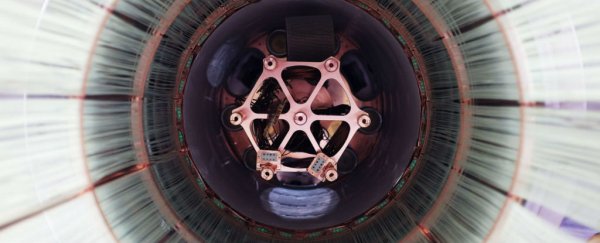The mystery of where all the antimatter is gets to the heart of why you and I, and everything else in the known Universe, exist, because the Big Bang technically should have initiated a process that instantaneously annihilated all matter.
But a strange form of radioactivity that physicists predict but have never seen could finally give us some clarity, and we've just gotten confirmation that a giant particle detector in Italy can actually nail it down - if it exists.
The radioactive decay physicists are chasing is called neutrinoless double-beta decay, and if we find it, it would be the evidence we need that in some strange circumstances, more matter can be produced than antimatter.
"If neutrinoless double-beta decay is observed, it helps solve a couple of problems," Philip Barbeau from Duke University, one of the physicists who reviewed the paper, told Live Science.
"For one, it helps to explain the matter-antimatter asymmetry in the Universe. It also helps explain why neutrino masses are so surprisingly small. We would also get an idea of the neutrino masses as well, as the decay rate is related to the mass scale of the neutrinos."
The matter-antimatter asymmetry problem stems from the fact that the Standard Model of physics predicts that equal amounts of matter and antimatter would have been produced by the Big Bang - but they should have both cancelled each other out.
That clearly didn't happen, because humans, trees, planets, galaxies, and this adorable floating dumpling are all made from matter that never got annihilated.
So where did all the antimatter go?
The answer could lie with neutrinos - nicknamed ghost particles, because we can't figure out how much they weigh, and they don't interact via electromagnetism, meaning there are craploads of them whizzing through the Universe, but we can't feel them.
It's been predicted that neutrinos could play the role of their own antineutrinos - hypothetical entities called Majorana particles - and this could be key to the asymmetry of the Universe.
To figure this out, researchers are using the Germanium Detector Array (GERDA) experiment in Italy, set deep inside a mountain in Grand Sasso, to investigate radioactive particles that have the potential to display natural asymmetry.
In regular radioactive particle decay, a neutral neutron breaks down into a positive proton, a negative electron, and an antineutrino - a process called beta decay.
But in germanium atoms, this process occurs twice - two neutrons decay simultaneously - and this could see the neutrinos annihilate themselves before exiting the atom.
So now we have a scenario called neutrinoless double-beta decay, where two neutrons turn into two protons within an atom, releasing two electrons, but no antineutrinos.
Regular matter just won out over antimatter.
As Sophia Chen explains for Wired:
"Theorists think that this process, known as neutrinoless double-beta decay, produces two electrons - but no antimatter.
Two new morsels of matter pop into existence in the Universe, and detectors should be able to measure them. If this process occurred enough times right after the Big Bang, it could explain where all the extra matter comes from."
Unfortunately, this process is incredibly difficult to detect in space, due to the background noise that comes with it, usually in cosmic ray form.
And that's where GERDA comes into play.
The team is now observing 35.6 kilograms of germanium inside a vat of liquid argon that's sitting inside an even larger vat of water, to watch it decay.
They're yet to witness neutrinoless double-beta decay, but "their experiment works really, really well," says Ryan F. Mandelbaum over at Gizmodo.
"There's no background noise, which is an incredible feat."
We'll have to wait for that germanium to decay in the vat now, but when it does, we could be witnessing something unprecedented. And then we can really get excited about the fate of physics as we know it.
"A discovery of [neutrinoless double beta] decay would have far-reaching consequences for our understanding of particle physics and cosmology," the GERDA team writes in their paper.
The study has been published in Nature.
